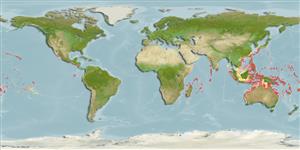Actinopterygii (ray-finned fishes) >
Perciformes (Perch-likes) >
Gobiidae (Gobies) > Gobiinae
Etymology: Fusigobius: Latin, fusus = spindle + Latin, gobius = gudgeon (Ref. 45335). More on author: Hoese.
Environment / Climate / Range
Ecology
Marine; reef-associated; depth range 1 - 46 m (Ref. 90102). Tropical, preferred ?
Indo-West Pacific: East Africa to the Society Islands, north to the Ogasawara Islands.
Size / Weight / Age
Maturity: Lm ? range ? - ? cm
Max length : 6.0 cm TL male/unsexed; (Ref. 2798)
Dorsal
spines
(total): 7;
Dorsal
soft rays
(total): 9;
Anal
spines: 1;
Anal
soft rays: 8. Body with dark dots found in rows; spot on caudal peduncle (Ref. 2798); characterized by semi-translucent grey body with orange-brown spots and blotches; outer part of first dorsal fin with two black spots; nearly fully united pelvic fins; weak pelvic frenum; rounded caudal fin; longitudinal scale series 24-25; ctenoid body scales becoming cycloid anterior to pectoral and pelvic fins; operculum without scales; opening of gill extending to or almost to vertical at posterior edge of opercle; depth of body 4.3-5.8 in SL (Ref. 90102).
Inhabits sandy floors of holes and depressions of clear seaward reefs. Also found in sand-rubble bottoms next to reefs (Ref. 90102). Occurs singly or in groups, secretive. (Ref. 37816, 48637). Benthic (Ref. 58302). Feeds on small invertebrates (Ref. 89972).
Life cycle and mating behavior
Maturity | Reproduction | Spawning | Eggs | Fecundity | Larvae
Randall, J.E., 1995. Fusigobius Whitley, a junior synonym of the gobiid fish genus Coryphopterus gill. Bull. Mar. Sci. 56(3):795-798. (Ref. 10930)
IUCN Red List Status (Ref. 115185)
CITES (Ref. 94142)
Not Evaluated
Threat to humans
Harmless
Human uses
More information
Common namesSynonymsMetabolismPredatorsEcotoxicologyReproductionMaturitySpawningFecundityEggsEgg development
ReferencesAquacultureAquaculture profileStrainsGeneticsAllele frequenciesHeritabilityDiseasesProcessingMass conversion
Tools
Special reports
Download XML
Internet sources
